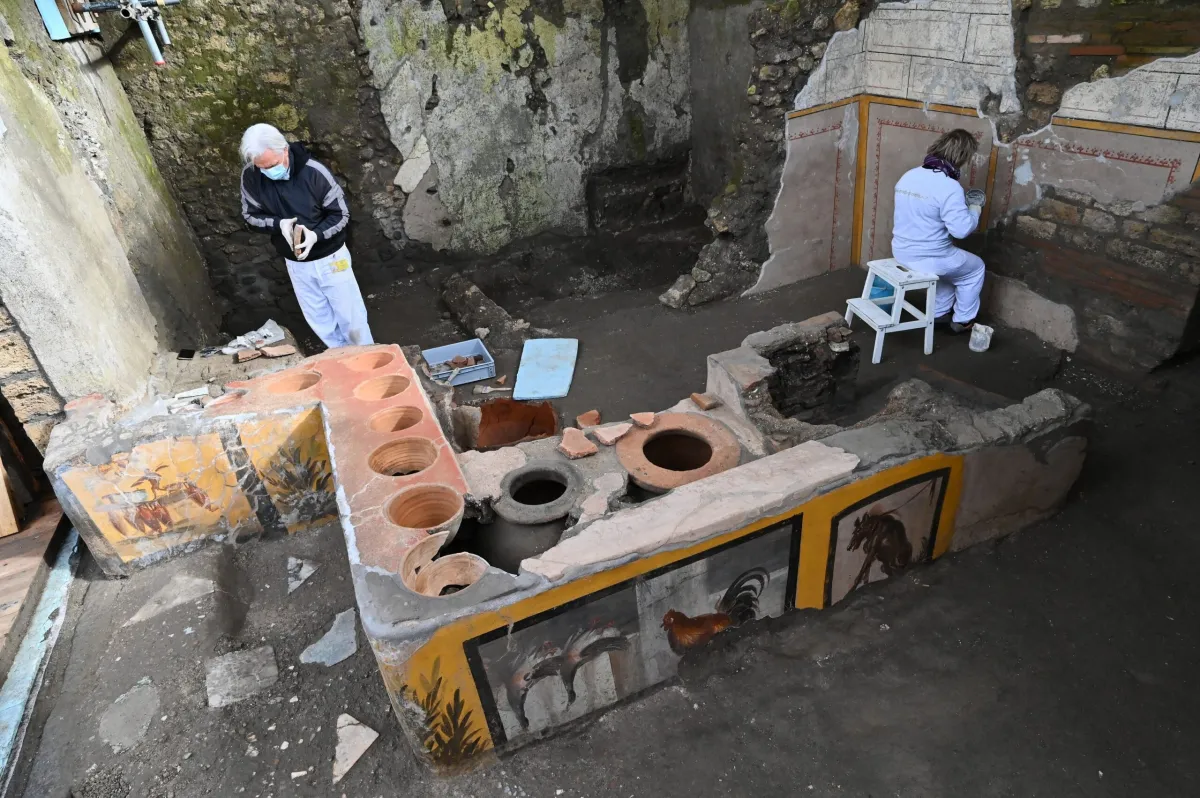In 79 A.D., hell rained down on the Roman city of Pompeii via an eruption plume from Mount Vesuvius visible for miles. Many fled, but at least two thousand people were still in the city when a pyroclastic surge moving 100 miles-per-hour, at temperatures over 9000 degrees, swept down from volcano and over the city. Pompeii, along with neighboring Herculaneum, wasn’t lost though, just buried, under feet of ash and debris.
It was not until 1748 that Pompeii was unearthed and archeologists discovered a place almost perfectly frozen in time that gave historians an incredible look into what day-to-day life was like in a Roman vacation destination city full of brothels, villas, and, yes, pubs. The excavations at Pompeii have continued and just in December of 2020, an incredible new discovery was made of what was essentially a restaurant or pub, called thermopolium.
This place is amazing. The walls are painted with nearly perfectly preserved frescos that give us a look at daily life in what was once a bustling hub. Cooking tools and even an image of someone delivering food are included in the art! Also included are a sea nymph riding a seahorse, a dog, ducks, and an incredible chicken.
But what’s really incredible is that the actual cooking tools and vessels are still there: Amphorae of wine and ceramic food storage containers called dolia. Pompeii was destroyed so quickly that archeologists have found bones in the dolia. These give us an idea of what these average Romans were eating. It’s important to understand that in a place like Pompeii, many people, even in the middle class, didn’t have their own hearth at home, so they had to eat at places like this.
And what did they eat? The same things we saw on the walls. Ducks, chicken, fish, as well as pigs, goats, and, um, snails. It’s even possible the frescos had a purpose beyond decoration for some people, though we can’t be sure. Pompeii was a travel destination and, like many places in the Roman Empire, a trade hub where people from all over the empire, which means many visitors may have spoken other tongues. Historians have theorized that some of the far more adult frescos and mosaics in the brothels functioned as a sort of menu for the services available. It’s entirely possible this was the case for a more literal menu at the thermopolium. If you wanted chicken and didn’t speak Latin, just point to it!
Discoveries like this are so extraordinary because they show us real, everyday life. You can look at the pictures of the thermopolium and immediately imagine walking in on a hot day, with the breeze from the bay of Naples wafting the scents of stewing meat towards you, while workers and travelers drank and ate before heading home or maybe off to the area for the latest spectacle.
Pompeii is a spectacular place and has just recently reopened its Antiquarium museum for the first time in 40 years, showcasing treasures from the on-going excavation and study on the site as well as those recovered recently. Pompeii itself is a time machine to a lost world and to a day of horror and tragedy that buried its wonders.
(via: Atlas Obscura, image: ANDREAS SOLARO/AFP via Getty Images)
Want more stories like this? Become a subscriber and support the site!
—The Mary Sue has a strict comment policy that forbids, but is not limited to, personal insults toward anyone, hate speech, and trolling.—










Published: Jan 28, 2021 04:04 pm